check engine CHEVROLET ASTRO 1998 2.G Repair Manual
[x] Cancel search | Manufacturer: CHEVROLET, Model Year: 1998, Model line: ASTRO, Model: CHEVROLET ASTRO 1998 2.GPages: 414, PDF Size: 21.46 MB
Page 322 of 414
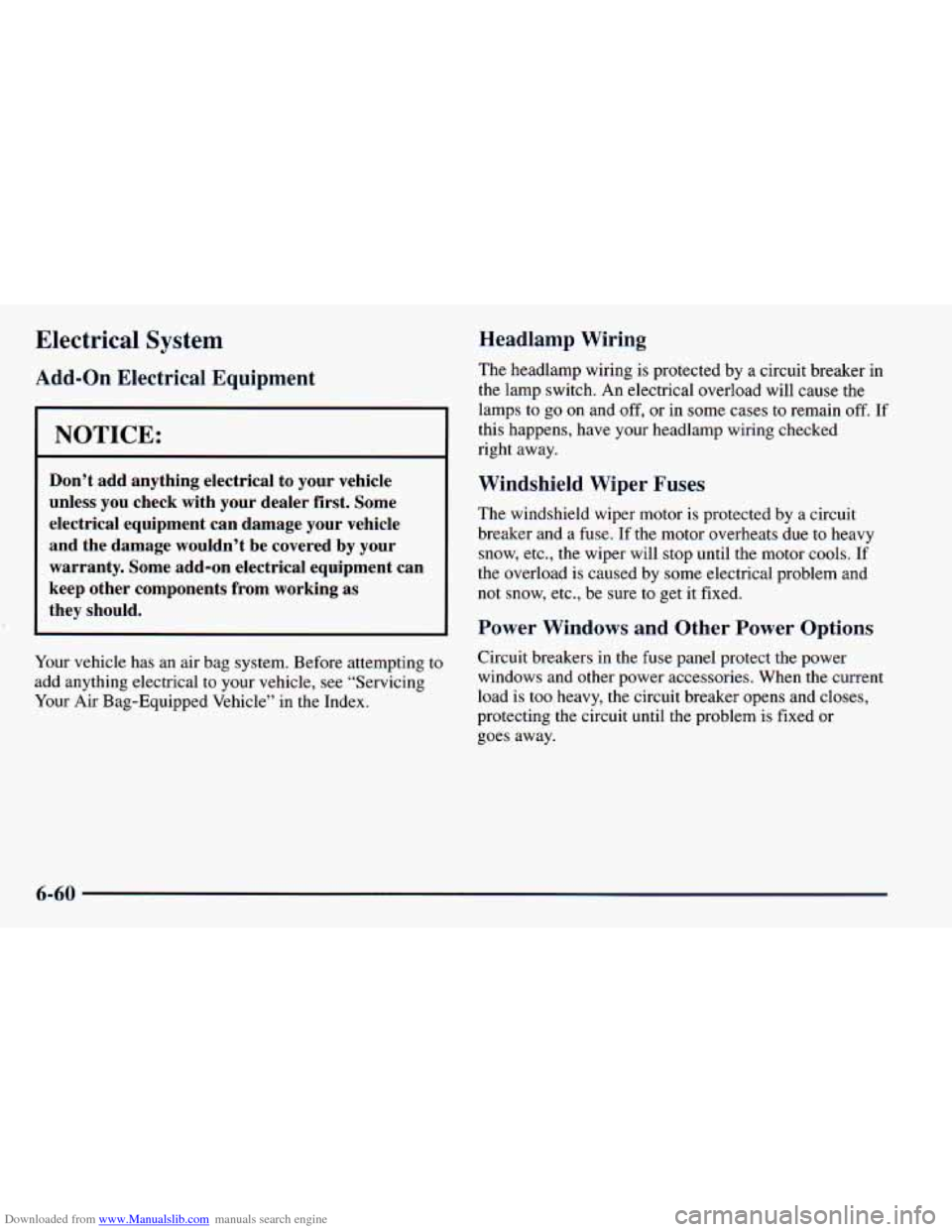
Downloaded from www.Manualslib.com manuals search engine Electrical System
Add-on Electrical Equipment
I NOTICE:
Don’t add anything electrical to your vehicle
unless you check with your dealer first. Some
electrical equipment can damage your vehicle
and the damage wouldn’t be covered by your warranty. Some add-on electrical equipment can
keep other components from working as
they should.
Your vehicle has an air bag system. Before attempting to
add anything electrical to your vehicle, see “Servicing
Your Air Bag-Equipped Vehicle” in the Index.
Headlamp Wiring
The headlamp wiring is protected by a circuit breaker in
the lamp switch. An electrical overload will cause the
lamps to go on and off, or in some cases to remain off. If
this happens, have your headlamp wiring checked
right away.
Windshield Wiper Fuses
The windshield wiper motor is protected by a circuit
breaker and a fuse. If the motor overheats due to heavy
snow, etc., the wiper will stop until the motor cools. If
the overload is caused by some electrical problem and
not snow, etc., be sure to get it fixed.
Power Windows and Other Power Options
Circuit breakers in the fuse panel protect the power
windows and other power accessories. When the current
load is
too heavy, the circuit breaker opens and closes,
protecting the circuit until the problem is fixed or
goes away.
6-60
Page 329 of 414
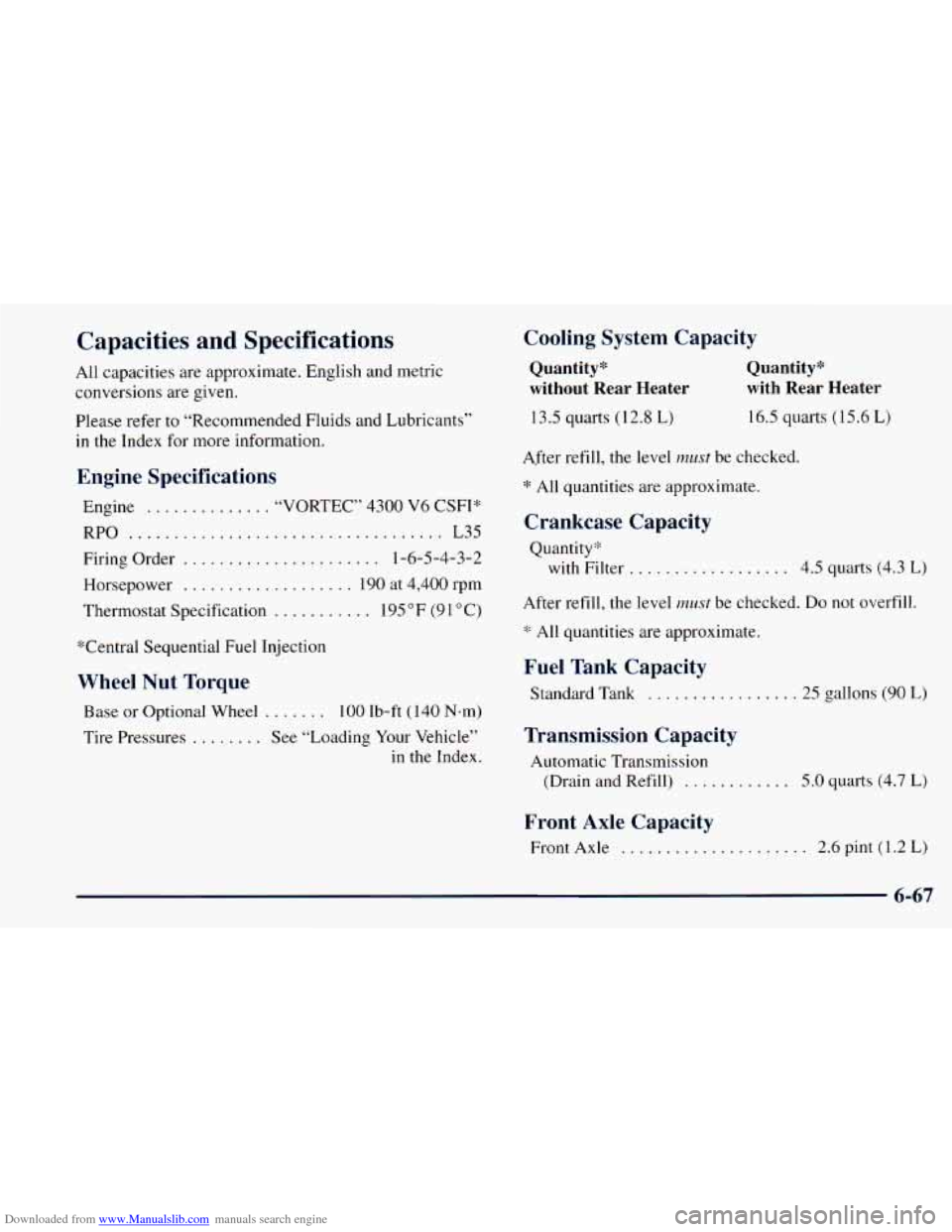
Downloaded from www.Manualslib.com manuals search engine Capacities and Specifications
All capacities are approximate. English and metric
conversions are given.
Please refer to “Recommended Fluids and Lubricants”
in the Index for more information.
Engine Specifications
Engine .............. “VORTEC” 4300 V6 CSFI*
RPO
................................. L35
Firing Order
...................... 1-6-5-4-3-2
Thermostat Specification
........... 195 OF (9 1 O C)
Horsepower
................... 190 at
4,400 rpm
*Central Sequential
Fuel Injection
Wheel Nut Torque
Tire Pressures ........ See “Loading Your Vehicle”
Base
or Optional Wheel ....... 100 lb-ft
(140 N-m)
in the Index.
Cooling System Capacity
Quantity” Quantity”
without Rear Heater with Rear Heater
13.5 quarts (12.8 L) 16.5 quarts (15.6 L)
After refill, the level
must be checked,
* All quantities are approximate.
Crankcase Capacity
Quantity”
with Filter
..... ........... 4.5 quarts (4.3 L)
After refill, the level
must be checked. Do not overfill.
* All quantities are approximate.
Fuel Tank Capacity
Standard Tank ................ .25 gallons (90 L)
Transmission Capacity
Automatic Transmission
(Drain and Refill)
............ 5.0 quarts (4.7 L)
Front Axle Capacity
Front Axle .......... . . 2.6 pint (1.2 L)
6-67
Page 335 of 414
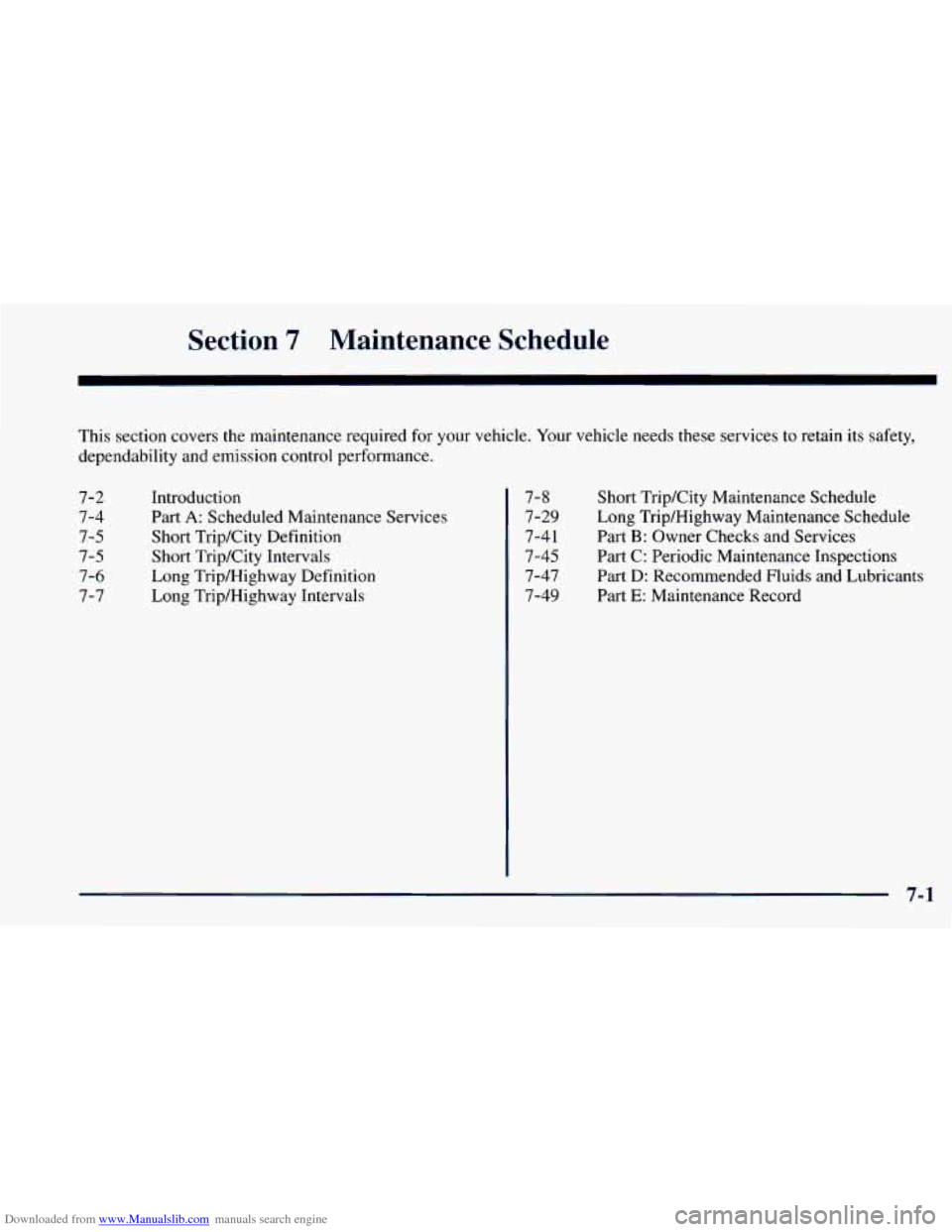
Downloaded from www.Manualslib.com manuals search engine Section 7 Maintenance Schedule
This section covers the maintenance required for your vehicle. Your vehicle needs these services to retain its safety,
dependability and emission control performance.
7-2
7-4
7-5
7-5
7-6
7-7 Short TripKity Maintenance Schedule
Long Trip/Highway Maintenance Schedule
Part
B: Owner Checks and Services
Part C: Periodic Maintenance Inspections
Part
D: Recommended Fluids and Lubric
Part
E: Maintenance Record Its
Introduction
Part
A: Scheduled Maintenance Services
Short Trip/City Definition
Short Trip/City Intervals
Long Trip/Highway Definition
Long Trip/Highway Intervals 7-a
7-29
7-4 1
7-45
7-47
7-49
7-1
Page 337 of 414

Downloaded from www.Manualslib.com manuals search engine How This Section is Organized
The remainder of this section is divided into five parts:
“Part
A: Scheduled Maintenance Services” shows
what
to have done and how often. Some of these
services can be complex,
so unless you are technically
qualified and have the necessary equipment,
you should
let your dealer’s service department or another qualified
service cpqter do these
job.
I
Performing maintenance work on a vehicle can
be dangerous. In trying to do some jobs, you can
be seriously injured.
Do your own maintenance
work only if you have the required know-how
and the proper
tools and equipment for the job.
If you have any doubt, have a qualified
technician do the work.
If you are skilled enough to do some work
on your
vehicle, you will probably want to get
the service
information. See “Service and Owner Publications”
in the Index. “Part
B: Owner Checks and Services”
tells you what
should be checked and when.
It also explains what you
can easily do to help keep your vehicle in good condition.
“Part
C: Periodic Maintenance Inspections” explains
important inspections that your dealer’s service department
or another qualified service center should perform.
“Part
D: Recommended Fluids and Lubricants’’ lists
some recommended products
to help keep your vehicle
properly maintained. These products, or their
equivalents, should be used whether you do the work
yourself or have it done.
“Part
E: Maintenance Record” provides a place for
you to record the maintenance performed on your
vehicle. Whenever any maintenance is performed, be
sure to write
it down in this part. This will help you
determine when your next maintenance should be done.
In addition,
it is a good idea to keep your maintenance
receipts. They may be needed
to qualify your vehicle for
warranty repairs.
7-3
Page 338 of 414

Downloaded from www.Manualslib.com manuals search engine Part A: Scheduled Maintenance
Services
Using Your Maintenance Schedule
We at General Motors want to help you keep your
vehicle
in good working condition. But we don’t know
exactly how you’ll drive
it. You may drive very short
distances
only a few times a week. Or you may drive
long distances all
the time in very hot, dusty weather.
You may use your vehicle in making deliveries. Or
you may drive
it to work, to do errands or in many
other ways.
Because of all the different ways people use their
vehicles, maintenance needs vary. You may even need
more frequent checks and replacements than you’ll find
in the schedules in this section. So please read this
section and note how you drive. If you have any
questions on how to keep your vehicle in good
condition, see your GM dealer.
This part tells you the maintenance services you should
have done and when you should schedule them. If you
go to your dealer for your service needs, you’ll know
that GM-trained and supported service people
will
perform the work using genuine GM parts. The
proper fluids and lubricants
to use are listed in
Part
D. Make sure whoever services your vehicle
uses these. All parts should be replaced and all
necessary repairs done before
you or anyone else
drives the vehicle.
These schedules are for vehicles
that:
carry passengers and cargo within recommended
limits.
You will find these limits on your vehicle’s
Certificationmire label. See “Loading Your Vehicle”
in the Index.
are driven on reasonable road surfaces within legal
driving limits.
0 use the recommended fuel. See “Fuel” in the Index.
Selecting the Right Schedule
First you’ll need to decide which of the two schedules is
right for your vehicle. Here’s how to decide which
schedule to follow:
7-4
Page 342 of 414
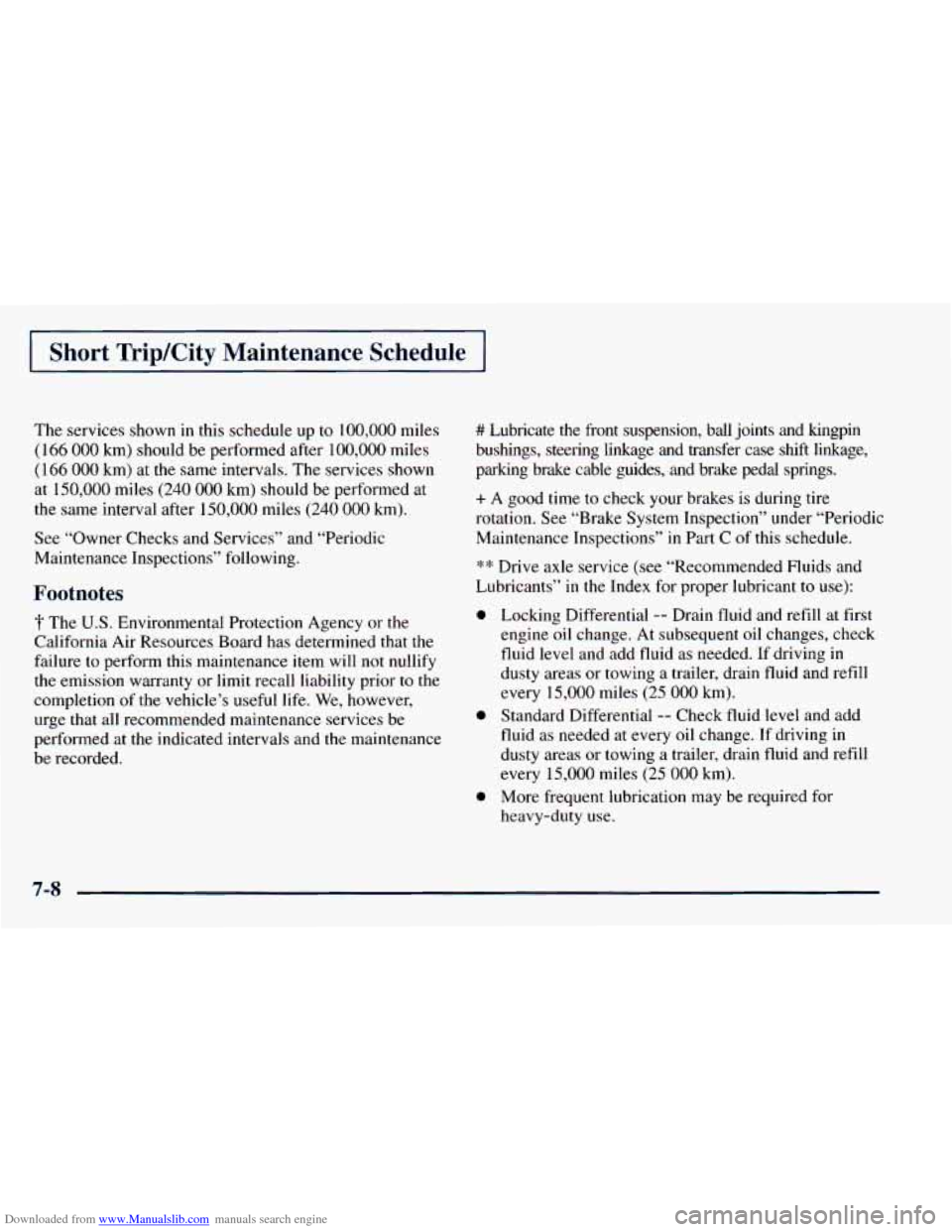
Downloaded from www.Manualslib.com manuals search engine Short TripKity Maintenance Schedule
The services shown in this schedule up to 100,000 miles
(166 000 km) should be performed after 100,000 miles
(166 000 km) at the same intervals. The services shown
at 150,000 miles
(240 000 km) should be performed at
the same interval after 150,000 miles (240 000 km).
See “Owner Checks and Services’’ and “Periodic
Maintenance Inspections” following.
Footnotes
The U.S. Envlronmental Protection Agency or the
California Air Resources Board has determined that the
failure to perform this maintenance item will
not nullify
the emission warranty or limit recall liability prior to the
completion
of the vehicle’s useful life. We, however,
urge that all recommended maintenance services be
performed at the indicated intervals and the maintenance
be recorded.
# Lubricate the front suspension, ball joints and kingpin
bushings, steering linkage and transfer case shift linkage,
parking brake cable guides, and brake pedal springs.
+ A good time to check your brakes is during tire
rotation. See “Brake System Inspection” under “Periodic
Maintenance Inspections” in Part
C of this schedule.
** Drive axle service (see “Recommended Fluids and
Lubricants”
in the Index for proper lubricant to use):
0
0
0
Locking Differential -- Drain fluid and refill at first
engine oil change. At subsequent oil changes, check
fluid level and add fluid as needed. If driving
in
dusty areas or towing a trailer, drain fluid and refill
every 15,000 miles
(25 000 km).
Standard Differential
-- Check fluid level and add
fluid as needed at every oil change. If driving in
dusty areas or towing a trailer, drain fluid and refill
every 15,000 miles
(25 000 km).
More frequent lubrication may be required for
heavy-duty use.
7-8
Page 343 of 414
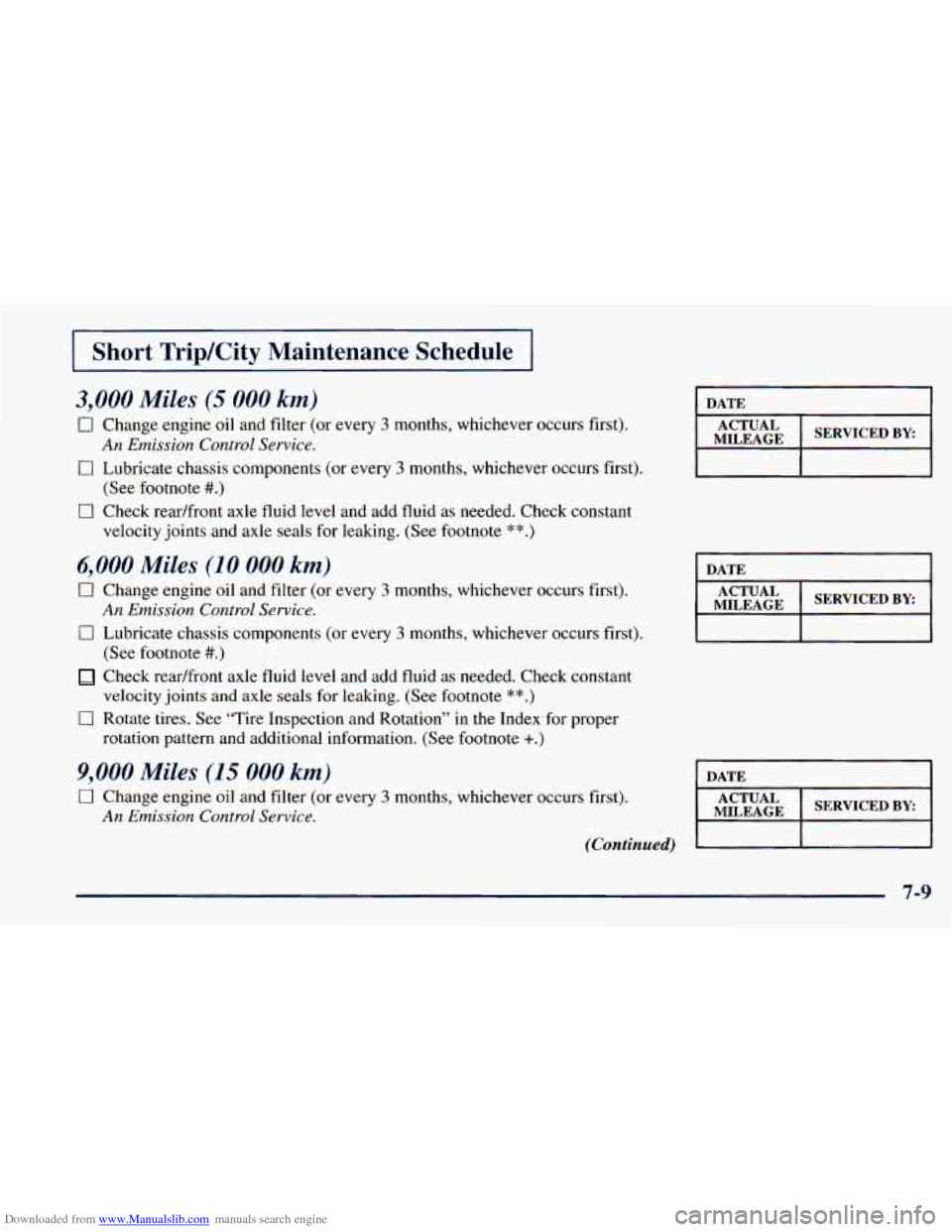
Downloaded from www.Manualslib.com manuals search engine I Short Trip/City Maintenance Schedule I
3,000 Miles (5 000 km)
0 Change engine oil and filter (or every 3 months, whichever occurs first).
0 Lubricate chassis components (or every 3 months, whichever occurs first).
0 Check readfront axle fluid level and add fluid as needed. Check constant
An Emission Control Service.
(See footnote #.)
velocity joints and axle seals for leaking. (See footnote **.)
6,000 Miles (10 000 km)
0 Change engine oil and filter (or every 3 months, whichever occurs first).
0 Lubricate chassis components (or every 3 months, whichever occurs first).
Check readfront axle fluid level and add fluid as needed. Check constant
0 Rotate tires. See “Tire Inspection and Rotation” in the Index for proper
An Emission Control Service.
(See footnote #.)
velocity joints and axle seals for leaking. (See footnote **.)
rotation pattern and additional information. (See footnote +.)
9,000 Miles (15 000 km)
0 Change engine oil and filter (or every 3 months, whichever occurs first).
An Emission Control Service.
1 DATE I
MILEAGE
DATE
I
DATE MILEAGE
ACTUAL SERVICED BY:
(Continued) I I
7-9
Page 344 of 414
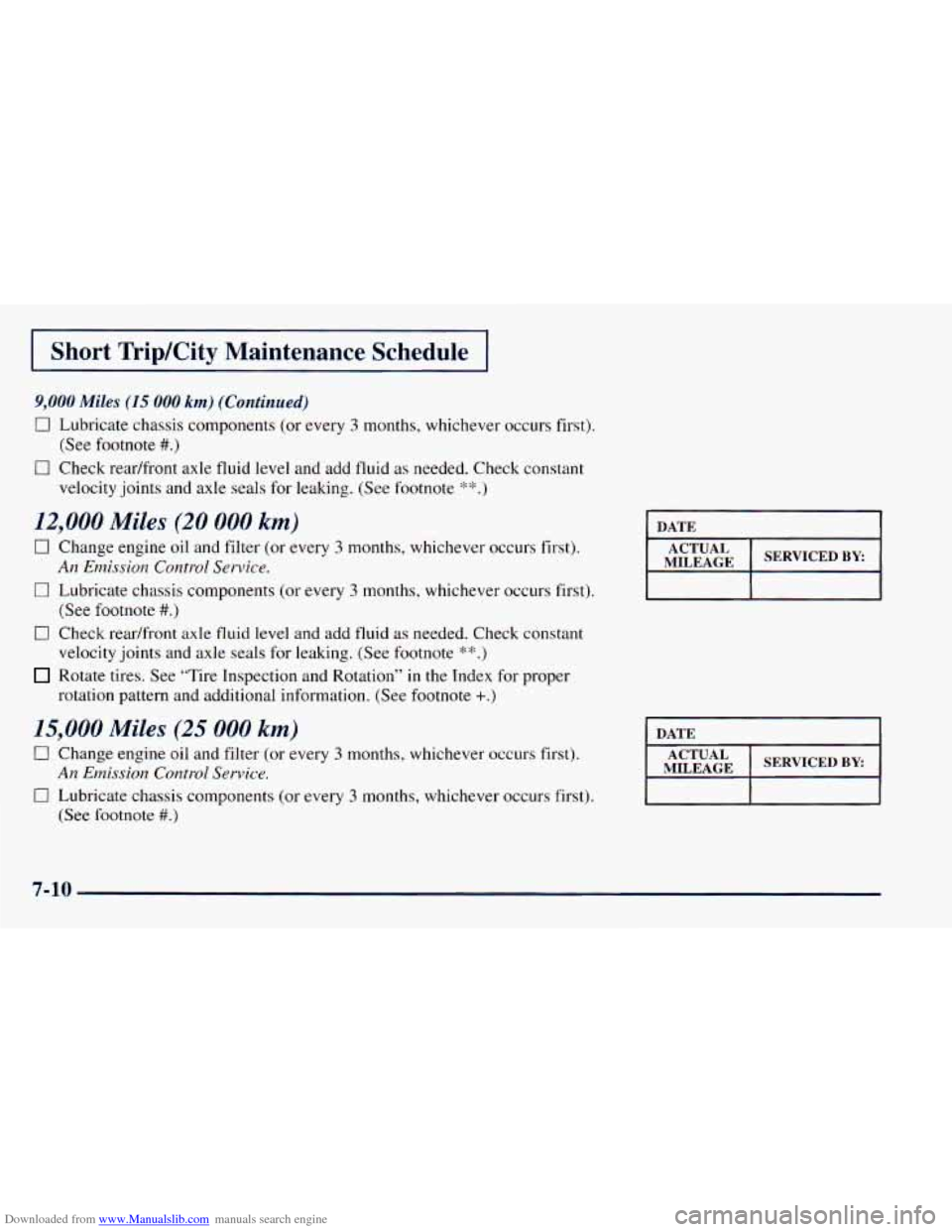
Downloaded from www.Manualslib.com manuals search engine I Short TripKity Maintenance Schedule I
9,000 Miles (15 000 km) (Continued)
0 Lubricate chassis components (or every 3 months, whichever occurs rlrst).
0 Check readfront axle fluid level and add fluid as needed. Check constant
(See
footnote
#.)
velocity joints and axle seals for leaking. (See footnote *:I:.)
12,000 Miles (20 000 km)
0 Change engine oil and filter (or every 3 months, whichever occurs first).
An Emission Control Service.
0 Lubricate chassis components (or every 3 months, whichever occurs first).
(See footnote
#.)
0 Check readfront axle fluid level and add fluid as needed. Check constant
Rotate tires. See “Tire Inspection and Rotation” in the Index for proper
velocity
joints and axle seals for leaking. (See footnote
**.)
rotation pattern and additional information. (See footnote +.)
15,000 Miles (25 000 km)
0, Change engine oil and filter (or every 3 months, whichever occurs first).
0, Lubricate chassis components (or every 3 months, whichever occurs first).
An Emission Control Service,
(See footnote #.)
DATE 1
MILEAGE
I DATE I
I MILEAGE ACTUAL I SERVICEDBX I
7-10
Page 345 of 414
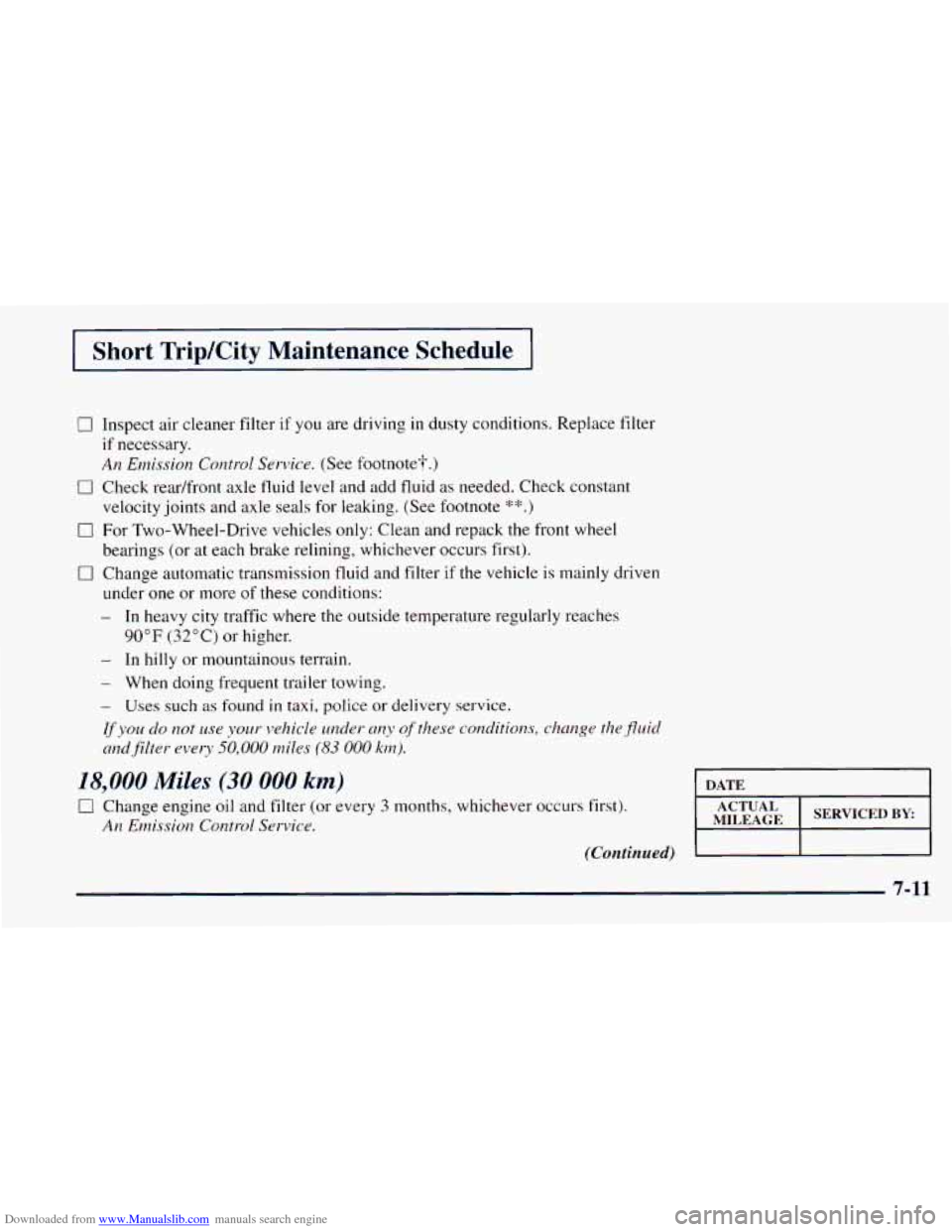
Downloaded from www.Manualslib.com manuals search engine 1 Short TripKity Maintenance Schedule I
0 Inspect air cleaner filter if you are driving in dusty conditions. Replace filter
if necessary.
An Emission Control Service. (See footnote?.)
velocity joints and axle seals for leaking. (See footnote
**.)
bearings (or at each brake relining, whichever occurs first).
under
one or more of these conditions:
0 Check readfront axle fluid level and add fluid as needed. Check constant
0 For Two-Wheel-Drive vehicles only: Clean and repack the front wheel
0 Change automatic transmission fluid and filter if the vehicle is mainly driven
- In heavy city traffic where the outside temperature regularly reaches
- In hilly or mountainous terrain.
- When doing frequent trailer towing.
90 OF (32 O C) or higher.
- Uses such as found in taxi, police or delivery service.
If you do not use yaw- vehicle under any of these conditions, change thejiruid
andfilter every
50,000 miles (83 000 km).
18,000 Miles (30 000 km)
0 Change engine oil and filter (or every 3 months, whichever occurs first).
An Emission Control Service.
7-11
Page 346 of 414
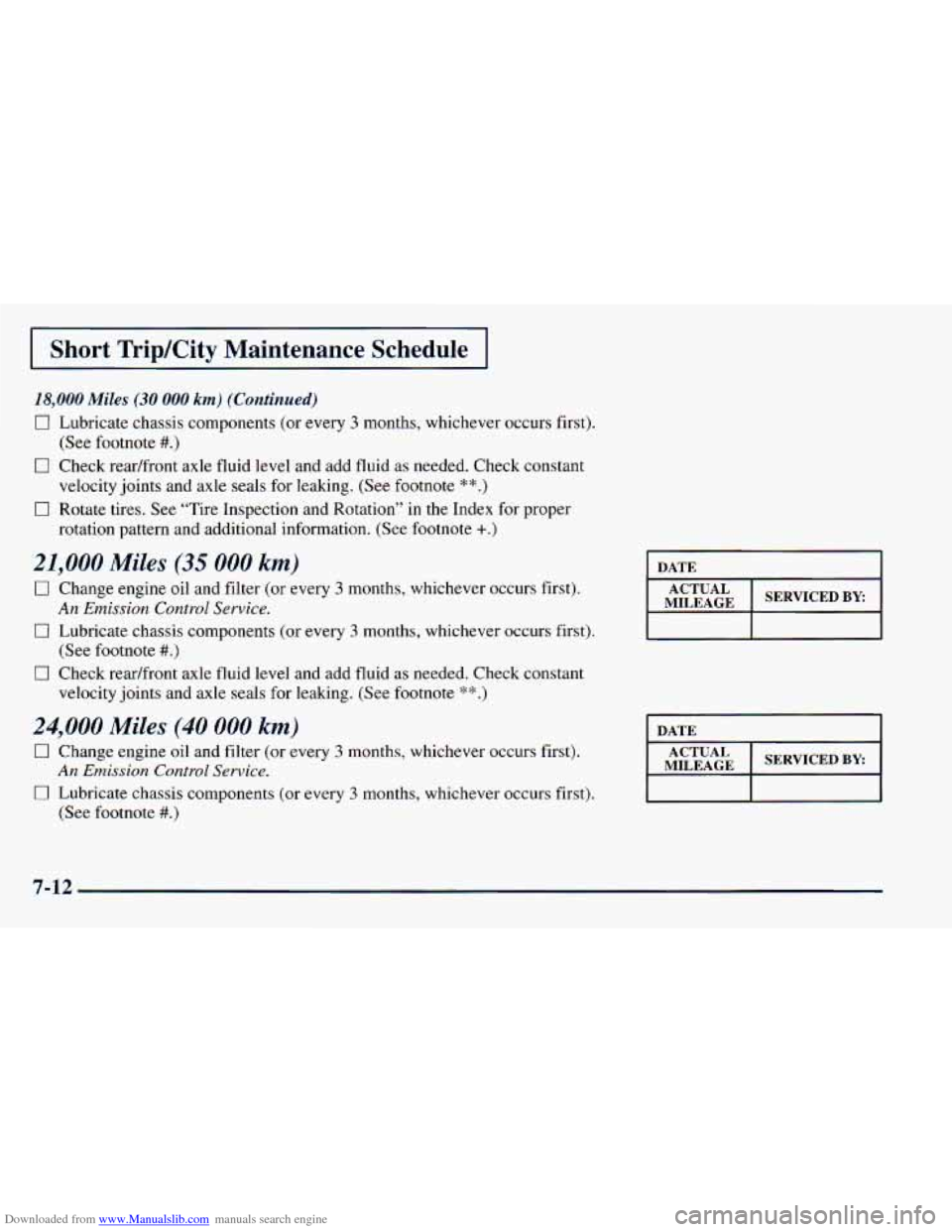
Downloaded from www.Manualslib.com manuals search engine I Short Trip/City Maintenance Schedule I
18,000 Miles (30 000 km) (Continued)
0 Lubricate chassis components (or every 3 months, whichever occurs first).
0 Check readfront axle fluid level and add fluid as needed. Check constant
0 Rotate tires. See “Tire Inspection and Rotation” in the Index for proper
(See footnote
#.)
velocity
joints and axle seals for leaking. (See footnote **.)
rotation pattern and additional information. (See footnote +.)
21,000 Miles (35 000 km)
0 Change engine oil and filter (or every 3 months, whichever occurs first).
0 Lubricate chassis components (or every 3 months, whichever occurs first).
0 Check readfront axle fluid level and add fluid as needed. Check constant
An Emission Control Service.
(See footnote #.)
velocity joints and axle seals for leaking. (See footnote **.)
24,000 Miles (40 000 km)
0 Change engine oil and filter (or every 3 months, whichever occurs first).
0 Lubricate chassis components (or every 3 months, whichever occurs first).
An Emission Control Service.
(See footnote #.)
DATE I
DATE I
7-12